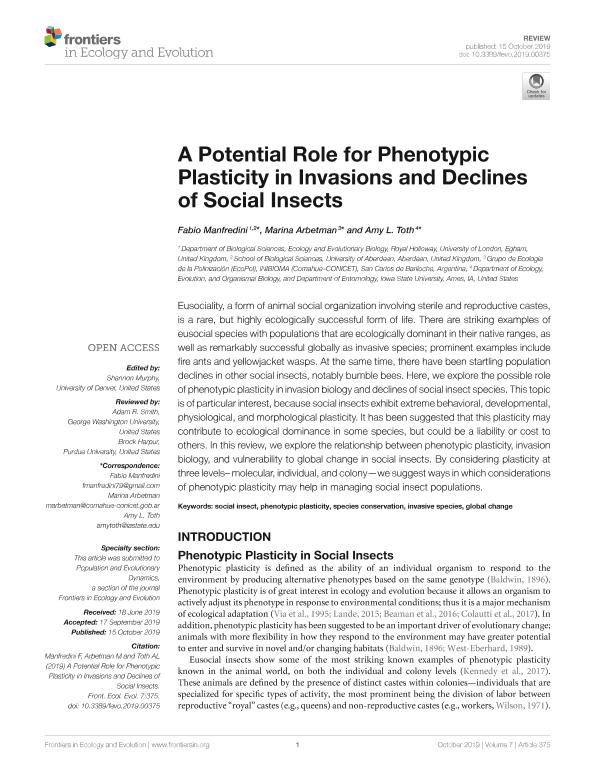Mostrar el registro sencillo del ítem
dc.contributor.author
Manfredini, Fabio
dc.contributor.author
Arbetman, Marina Paula

dc.contributor.author
Toth, Amy L.

dc.date.available
2021-01-08T17:51:52Z
dc.date.issued
2019-10
dc.identifier.citation
Manfredini, Fabio; Arbetman, Marina Paula; Toth, Amy L.; A Potential Role for Phenotypic Plasticity in Invasions and Declines of Social Insects; Frontiers Media S.A.; Frontiers in Ecology and Evolution; 7; 10-2019; 1-17
dc.identifier.issn
2296-701X
dc.identifier.uri
http://hdl.handle.net/11336/122002
dc.description.abstract
Eusociality, a form of animal social organization involving sterile and reproductive castes, is a rare, but highly ecologically successful form of life. There are striking examples of eusocial species with populations that are ecologically dominant in their native ranges, as well as remarkably successful globally as invasive species; prominent examples include fire ants and yellowjacket wasps. At the same time, there have been startling population declines in other social insects, notably bumble bees. Here, we explore the possible role of phenotypic plasticity in invasion biology and declines of social insect species. This topic is of particular interest, because social insects exhibit extreme behavioral, developmental, physiological, and morphological plasticity. It has been suggested that this plasticity may contribute to ecological dominance in some species, but could be a liability or cost to others. In this review, we explore the relationship between phenotypic plasticity, invasion biology, and vulnerability to global change in social insects. By considering plasticity at three levels–molecular, individual, and colony—we suggest ways in which considerations of phenotypic plasticity may help in managing social insect populations.
dc.format
application/pdf
dc.language.iso
eng
dc.publisher
Frontiers Media S.A.

dc.rights
info:eu-repo/semantics/openAccess
dc.rights.uri
https://creativecommons.org/licenses/by/2.5/ar/
dc.subject
GLOBAL CHANGE
dc.subject
INVASIVE SPECIES
dc.subject
PHENOTYPIC PLASTICITY
dc.subject
SOCIAL INSECT
dc.subject
SPECIES CONSERVATION
dc.subject.classification
Biología

dc.subject.classification
Ciencias Biológicas

dc.subject.classification
CIENCIAS NATURALES Y EXACTAS

dc.title
A Potential Role for Phenotypic Plasticity in Invasions and Declines of Social Insects
dc.type
info:eu-repo/semantics/article
dc.type
info:ar-repo/semantics/artículo
dc.type
info:eu-repo/semantics/publishedVersion
dc.date.updated
2020-11-19T22:53:55Z
dc.journal.volume
7
dc.journal.pagination
1-17
dc.journal.pais
Suiza

dc.journal.ciudad
Lausana
dc.description.fil
Fil: Manfredini, Fabio. University of London; Reino Unido. University of Aberdeen; Reino Unido
dc.description.fil
Fil: Arbetman, Marina Paula. Consejo Nacional de Investigaciones Científicas y Técnicas. Centro Científico Tecnológico Conicet - Patagonia Norte. Instituto de Investigaciones en Biodiversidad y Medioambiente. Universidad Nacional del Comahue. Centro Regional Universidad Bariloche. Instituto de Investigaciones en Biodiversidad y Medioambiente; Argentina
dc.description.fil
Fil: Toth, Amy L.. Iowa State University; Estados Unidos
dc.journal.title
Frontiers in Ecology and Evolution
dc.relation.alternativeid
info:eu-repo/semantics/altIdentifier/url/https://www.frontiersin.org/article/10.3389/fevo.2019.00375/full
dc.relation.alternativeid
info:eu-repo/semantics/altIdentifier/doi/http://dx.doi.org/10.3389/fevo.2019.00375
Archivos asociados
